
Tilly’s photo was gifted to us by one of our very first customers
This is a two part article written for our newsletter for February, dental health month. This first part discusses the pros and cons of some of the chews we carry.
There are certainly a lot of safety considerations to be made when you’re choosing any dog chew. You have to factor in how tenacious and destructive your chewer is to make sure she doesn’t break off and swallow big pieces, whether they’re the type that needs to be supervised so that they don’t choke on or gulp down something that they’ve softened up, and how healthy their teeth are, etc.
The truth is that every chew has some sort of risk, as dogs can be so “creative” about how they approach and handle each item. Any hard item could damage a tooth if the dog were to bear down and try and crush or break it instead of steadily gnawing away at it. Anything that they can soften can become a swallowing or choking hazard, as are things that are too small for their mouths. Other toys like frisbees can wear their teeth down over time making them more vulnerable to damage by harder chews.
Older dogs may also have weaker teeth.
The big thing that people don’t often realize is that dogs that eat dry food their whole lives often have weaker teeth, for two reasons related to processed food diets: 1) All kibble requires the use of starchy carbohydrates to bind the food and make those little nuggets. These simple carbs can linger in their mouths and then break down into simple sugars. Bacteria feed on these sugars and produce acid, which causes tooth decay. 2) These carbohydrates also contain phytic acid found in many plant based foods (grains, peas, lentils, rice, corn, soy, etc) which can inhibit the absorption of calcium, magnesium, iron, and zinc, all minerals necessary for oral health.
The takeaway here is NOT that you shouldn’t provide chews to dogs because you fear risk. Chewing is an essential activity for dogs, and those that don’t provide appropriate chews might quickly find their dogs becoming destructive to furniture or shoes, etc.
Chewing can be a very calming activity to anxious dogs, helps to dissipate extra energy that would otherwise distract you from your work at home (it can even wear a dog out as much as a big walk), provides enrichment that helps to alleviate boredom, and most importantly helps to keep teeth cleaner and gums healthier. Coyotes, wolves, etc keep their teeth plaque free with their natural diet of meat, organs and especially crunching through little bones and cartilage, and gnawing the meat and marrow from bigger bones. The key to safety is choosing something that suits your dog’s chewing style, knowing the risks associated with each type so that you can supervise your dog to make sure that they’re chewing appropriately. Once you feel confident that you know which chews your dog does well with, you can leave them more unsupervised with their favorite chews. Generally, the larger the chew, the safer it is as less of it can fit into their mouths at a time. Hard chews that are flat generally carry a larger risk of fracturing a tooth than round hard chews, as they can’t bear down as easily on those. Remember that humans who have a tooth that’s on the verge of breaking anyway might find it happening on a piece of popcorn!
Here are some of our favorite chews:
Buffalo Scapula And Trachea Tubes!
Edible chews like a buffalo scapula and trachea tubes are eaten away as
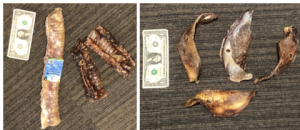
Photo by Green Dog Pet Supply
they chew, so they’re unlikely to hurt a tooth and big enough not to be swallowed whole. We don’t carry pig ears due to the difficulty of finding a supply that isn’t from factory farmed pigs, but a buffalo scapula (pictured on the right) is like a larger and more durable version of pig ear. They’re not as long lasting as a bully stick, but definitely a good little project, whereas a pig ear is often gone in a crunchy flash. Bison Tubes (pictured in the left photo), are a thicker material and Beef trachea Tubes (the ones we carry are thinner but longer than the bison tubes) are another good little project . They’re hard and crunchy and rich in nutrients like glucosamine and chondroitin, which are supportive to your dog’s joint health.
For smaller dogs, we have single small slices of trachea pieces which are a good little project for puppies. These small slices can also be purchased in one pound bags, which is a really good deal. These bags are actually a wonderful thing for bigger dogs as well. Of course they’re not a big project, but we were surprised to find they take some minutes to work on for many dogs, which can buy you a little time and create a moment of calm for the dog at a good price. Using them every day is a good habit for benefiting dental health as well. Daily chewing arguably gives more benefit than a once a week bully stick. Once you’re happy with how they do with them, they’d be a great treat to give them as you go out the door to make that moment positive for them, or to reward a great recall.
Bully Sticks!
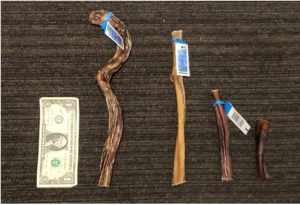
Photo by Green Dog Pet Supply
Bully Sticks are a great standby chew. They take some dogs a very long time to chew (especially puppies) and for other dogs it’s quite a bit faster. The upsides are that they’re great teeth cleaners that get way back there to the molars and soften as they chew so can help “floss” a bit. They’re high in protein and low in fat, and are very high value to dogs. The downsides are that they are fairly spendy if you have a super fast chewer and could become a little floppy or stringy depending on your dog’s chewing style. The other potential risk could be swallowing the last piece. We have a few devices to help hold a bully stick or
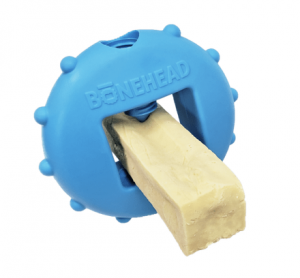
The “Bonehead” is made by Himalayan Pet and is made to hold a chew by using a screwdriver to tighten its hold (photo by Himalayan Pet)
other long chew like Himalayan cheese sticks, but the best strategy is to supervise until you know for sure how your dog manages any chew. Holding one end while your puppy chews the other can be a nice way to watch TV together, and and a good way to work on “Drop It”. I recently saw a funny idea to attach a pair of vice grip pliers to the end of the stick to prevent the last bite from being eaten. It’s not the worst idea.
We also like our beef and bison products to be from the USA (South American cattle are responsible for significant deforestation and habitat loss) and raised without feed lots. Bison used to be guaranteed pastured, but nowadays feed lots are sometimes used.
Antlers!
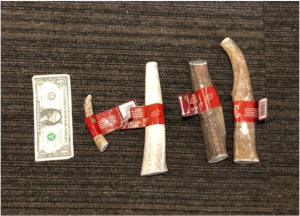
Photo by Green Dog Pet Supply
The longest lasting chew are Elk or deer Antlers. Antlers are very humane as they are naturally shed by deer and elk every year and sold as dog chews. (In nature, forest creatures like squirrels and rabbits like to chew them too!) They come in a variety of sizes. The upsides: Nothing outlasts them, and they don’t generally splinter or stink. Usually they provide months of chewing, so they offset what appears to be a big sticker price. Most antlers are fairly round, which means dogs teeth slip off the sides, encouraging safer gnawing. (we don’t love the flat “split” antlers, as dogs can more easily bear down on them an hurt a tooth. There’s nothing to ingest so they’re a good thing for crates (unless they’ve worn the antler down small, so be smart about throwing them away before this happens).
The downsides of course are that it’s a hard chew, so could hurt a tooth if the dog is intent on trying to break the antler. Vets do worry about this as they are of course the ones that see the instances where teeth are damaged, but honestly we’ve sold thousands of antlers in our 16 years of selling them and have only had 3 or maybe 4 reports of tooth damage (two were older dogs, one with cancer, and one was a puppy). Note: Smaller softer puppy teeth might conceivably be damaged by hard chews. We don’t hear of it often, but this doesn’t mean a risk doesn’t exist. Some puppies are soft chewers and some are voracious. Hard chewers could even damage the adult teeth that are waiting to come in right behind the smaller puppy teeth. The upsides for puppies are that there are few other ways they could have trouble with them. They don’t carry the risks of swallowing or making them need to potty in a crate (like a Kong full of food might), but all chews are a judgement call on your part.
There are a few dogs out there that can really burn through an antler quickly, which isn’t ideal. Those dogs probably shouldn’t have them, as they might be wearing their teeth down more quickly. In our opinion those dogs need more exercise to burn off their energy! The flip side is that some dogs are frustrated by not being able to make headway with antlers, so they don’t even bother trying… It all comes down to choosing chews that match their chewing style and age, and supervising to see how they handle any new chew.
Poultry Necks!
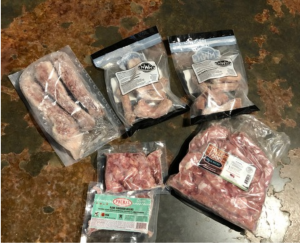
Photo by Green Dog Pet Supply
Some of the very best teeth cleaners are chicken necks, duck necks and turkey necks (suiting 3 sizes of dog). It’s very true that COOKED poultry bones are very dangerous to dogs, as they can be sharp and splintery. Raw necks are different. The bones in the neck are tiny and crunchy and surrounded with connective tissue and cartilage. They’re safe to chew through and very supportive nutritionally. Our favorite holistic vet recommends three raw poultry parts a week in place of commercial joint supplements, due to the high levels of natural glucosamine and chondroitin and other joint supporting nutrients in the collagen and connective tissues of bone in a highly bio-available state.. As they eat them, their teeth and gums are also getting a great flossing! The enzymes in the raw meat help to fight bacteria in the mouth. Dogs love them, and many cats love chicken necks too (either whole, which is often a young cat’s game, or in 1/2 inch slices). This was Otis the cat’s favorite treat! Check out the video in this blog post and turn on the sound!
Necks have another nice benefit for dogs with anal gland issues – several chicken necks a week can make nice hard stools that help to express the anal glands more effectively.
Most dogs and cats eat necks by chewing it as they go. I could conceive of a situation where a dog might gulp a whole neck and choke, but I’ve never heard of it. Remember that dogs and cats are designed to eat something like a bird, squirrel, or rat as well as shearing meat from even larger bones. It’s very enriching for them to work away at it and enjoy it. I also think that a neck would be fairly digestible if they did swallow a larger piece. Dogs are also designed to bring up a piece of meat that’s too big and re-chew it to give it another go. (Gross, but efficient and natural behavior) Try to choose the appropriate size for your dog or cat and like anything, watch them as they eat them.
Raw Meaty Bones!
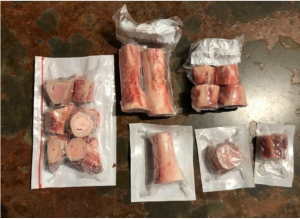
Photo by Green Dog Pet Supply
We also carry raw meaty marrow bones (beef and bison) in a variety of sizes. Ideally for safety any recreational bone or chew would be as big as their head, so they can’t bear down on any hard surface, but those aren’t available for us to buy. (In Portland, Gartner’s maybe? Ask your local butcher if they have big knuckle bones). Perhaps you might choose the larger of the sizes we have so they can’t fit as much between their back teeth. Stripping the bone of the stuff on the outside and emptying the marrow from the center (like a natural Kong!) is the valuable project. Shorter bones will give them more access to the marrow. Enzymes in the raw meat help to fight bacteria in the mouth and working around all of the surfaces scrubs the teeth. You can leave them to gnaw on the cleaned-out bone, or you might want to chuck it in the curbside compost bin (in Portland, bones are allowed in there), especially if they’ve eaten kibble for years or have a history of tooth problems. Some dogs will even work away to consume the bone itself – our raw fed dogs on staff often do this and their teeth are sparkling. If they’ve never had a raw meaty bone before, it might be a good idea to introduce it slowly to avoid digestive surprises, either by allowing 15 or so minutes with it and putting it back in the fridge for tomorrow, or cleaning out some of the marrow before giving it to them so they consume less at first (It could be a little rich). Like for our own food, raw meat should be discarded after 3 days in the fridge. FYI for our customers: The Primal 6pk of bones has a frequent buyer program!
Chew Sticks For TheTeenie Weenies!
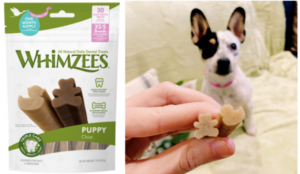
Photo from Whimzees’ website
When puppies are super young, they need chews that are softer and smaller than those for older dogs. These Whimzees puppy sticks are so useful for this purpose! They come in 2 sizes: XS/S for puppies as little as 5lb (30 chews gives you a whole month of chews for $9.99), and MD/L for puppies 20lb and up. Many of you with adult dogs already like the potato based Whimzees sticks, alligators, hedgehogs and toothbrushes (available in big and small sizes) for their simple ingredients. They’re gentle on teeth but seem pretty effective at keeping them clean. They’re also great for sensitive tummies, dogs with pancreatitis, protein allergies, etc. and available in a variety of sizes. We’re happy to have these new little puppy versions for the youngsters.
Big Bones For The Big Guys!
Customers love the 4-5 inch “Split Shins” for dogs that need a project. The
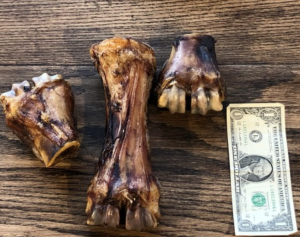
Photo by Green Dog Pet Supply
downside could be that it’s another hard bone, but the upsides are that they’re very durable and even more importantly, they can create another sort of chewing style. They’re covered in dried connective tissue, so dogs have a different sort of project to try and strip the outside off. People love them for their big chewers, and also for smaller dogs who like the stripping project. They’re too big to swallow which is nice. The split shins also have a small marrow end that the dogs might spend time trying to lick out. We’re very happy to have recently found the 9-10” Full Shins too! These have the knuckle on both ends and lots more “project” material on the outside.
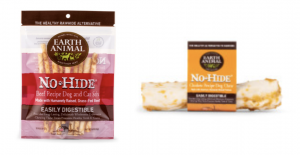
Images provided by Earth Animal
Earth Animal has created a nifty product for those of us that refuse to by rawhides. Rawhides are typically manufactured with multiple rounds of chemical treatments, some of which can be toxic. Various coatings and dyes are used to make it look and smell attractive. These treatments can contain carcinogenic dyes like red 40, and studies suggest that preservatives like sodium benzoate may increase their risk of inflammation, oxidative stress, obesity, ADHD, and allergies. It may also convert to benzene, a potential carcinogen. That’s not the worst of it though, as rawhides are not digestible when swallowed, and larger pieces can create dangerous blockages that may require surgery.
No Hides by Earth Animal are plant based recipes that look and chew much like rawhide, but are 80% more digestible than rawhide. They’re basted in yummy flavors (the animal proteins are certified humanely raised) and come in packs of tiny sticks for tiny dogs, and larger 4″, 7″, and 11″ sizes for bigger dogs. 80% is definitely significantly better than rawhide’s digestibility, but you must remember that swallowing any large piece of No Hides could still create a blockage. Choose the size that’s less likely to be swallowed whole and watch your dogs to see that they’re working on it and getting only small bits at a time as they chew. The texture is such that it does have good tooth cleaning benefits, and the basted flavors are popular with many dogs.
Knee caps are smallish but have quite a bit of yummy dried stuff to work on on the outside. Ours are
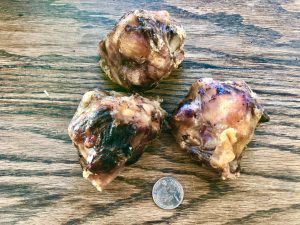
Photo by Green Dog Pet Supply
USA pasture raised and pasture finished buffalo. As always, It’s a good idea to supervise dogs with smaller chews they haven’t had before. Some big dogs do great with these, some might be tempted to swallow the bone when all of the good stuff has been gnawed off. They’re definitely a great project for little dogs!
Cat Chews!
Cat chews are hard to find – Don’t miss the the section above about chicken necks with a video of
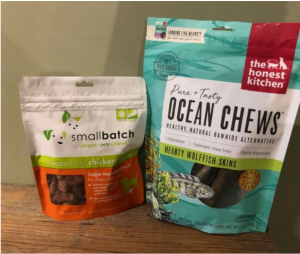
Photo by Green Dog Pet Supply
Otis chewing a big piece! These products are great for little dogs as well:
Freeze Dried Chicken Hearts!
Honest Kitchen makes a dehydrated fish skin chew that’s super safe and delicious. Made with MSC certified fish, these chews come in two lengths, but you can cut any of them to smaller sizes with kitchen shears. These are a one-ingredient, human grade, high protein, keep-them-occupied-for-a-bit chew that’s a natural and healthier alternative to rawhide. Each chew is packed with Omegas to promote healthy skin and a shiny coat. A great chew for all dogs, even seniors and puppies. Extra bonus – many cats love chewing on these as well!!

